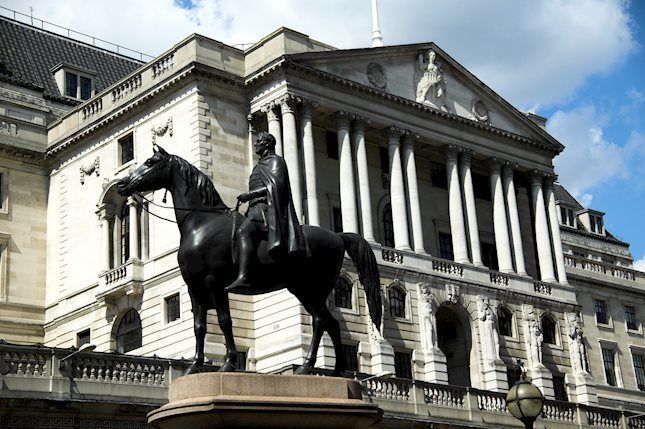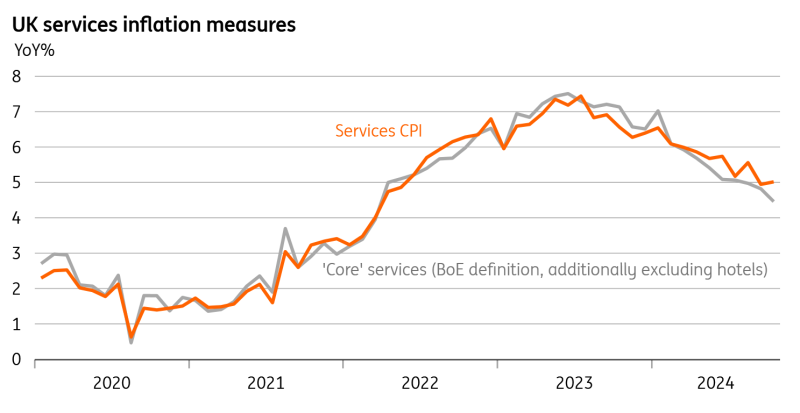Services inflation is set to bounce around 5% into the winter, while headline CPI could get close to 3% in January. That reduces the chance of a rate cut in December, but in the spring, we think there is still a good chance the Bank of England will accelerate its easing cycle.
UK services inflation was a tad hotter than the economist consensus had expected in October. But at 5%, it’s only fractionally higher than in September and in line with the Bank of England’s (and our own) forecast. Interestingly though, when we drill down into the details, you discover that much of the recent stickiness is in categories that the Bank seems to deem less important/less indicative of inflation “persistence”.
That’s things like rents, which were particularly strong on a month-on-month basis in October, though this could feasibly be related to social rents, which are only updated quarterly. Airfares and package holidays, notoriously volatile categories, also explain some of the latest pick-up in services inflation.
The Bank of England likes to strip those things out and focus on so-called “core services” inflation. There’s no single definition, but our favoured measure in the chart below, emulating work the BoE has done previously, fell from 4.8% to 4.5%. That’s quite a different story from what the headline services number is telling us.
'Core services' inflation is falling faster than the headline number
Core services based on a measure used in the May 2024 Monetary Policy Report
Source: Macrobond, ING calculations
Does this make any difference to the December Bank of England decision? We doubt it, though remember we do still have another reading before then. We, like the BoE, expect services inflation to bounce around 5% for the next four months or so before turning more noticeably lower in the second quarter. At the same time, headline inflation could get pretty close to 3% in January, albeit mainly because of energy. All of that means the Bank will most likely continue its “gradual” rate-cutting path for now, which is widely taken to mean one cut per quarter. We expect a pause at next month's meeting.
But that nuance about core services inflation is important. We think that the downtrend will continue, albeit maybe not in the next couple of months. Assuming it does, we think that means the Bank of England can in time become more aggressive on cuts. Timing that isn’t easy, but we think a rate cut in February, followed by another in March (and back-to-back cuts thereafter) is still a reasonable base case.
Read the original analysis: Sticky UK services inflation to keep BoE cutting gradually (for now)
Content disclaimer: This publication has been prepared by ING solely for information purposes irrespective of a particular user's means, financial situation or investment objectives. The information does not constitute investment recommendation, and nor is it investment, legal or tax advice or an offer or solicitation to purchase or sell any financial instrument. Read more here: https://think.ing.com/content-disclaimer/
Recommended Content
Editors’ Picks

EUR/USD extends losses to 1.0550 after ECB Negotiated Wages data
EUR/USD holds lower ground near 1.0550 in European trading on Wednesday. The US Dollar resurgence alongside the US Treasury bond yields higher weighs on the pair. Meanwhile, ECB reported Negotiated Wage Rates rose 5.42% in Q3 but this data failed to support the euro.

GBP/USD reverses toward 1.2650, erases UK CPI-led gains
GBP/USD is falling back toward 1.2650 in the European session on Wednesday, having erased UK CPI inflation-data-led gains. The data from the UK showed that the annual inflation, as measured by the change in the CPI, rose to 2.3% in October from 1.7% in September. Fedspeak awaited.

Gold price moves away from one-week top on rising US bond yields, modest USD strength
Gold price retreats after touching a one-and-half-week top earlier this Wednesday and drops to a fresh daily low, below the $2,630 level heading into the European session. A goodish pickup in the US Treasury bond yields, bolstered by bets for a less aggressive policy easing by the Fed, revives the USD demand and undermines demand for the non-yielding yellow metal.

Why is Bitcoin performing better than Ethereum? ETH lags as BTC smashes new all-time high records
Bitcoin has outperformed Ethereum in the past two years, setting new highs while the top altcoin struggles to catch up with speed. Several experts exclusively revealed to FXStreet that Ethereum needs global recognition, a stronger narrative and increased on-chain activity for the tide to shift in its favor.

Sticky UK services inflation to keep BoE cutting gradually
Services inflation is set to bounce around 5% into the winter, while headline CPI could get close to 3% in January. That reduces the chance of a rate cut in December, but in the spring, we think there is still a good chance the Bank of England will accelerate its easing cycle.

Best Forex Brokers with Low Spreads
VERIFIED Low spreads are crucial for reducing trading costs. Explore top Forex brokers offering competitive spreads and high leverage. Compare options for EUR/USD, GBP/USD, USD/JPY, and Gold.
